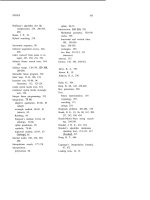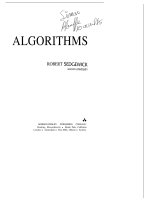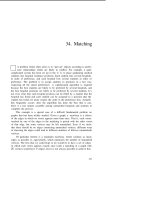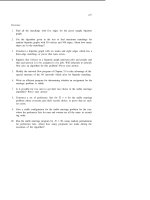Tài liệu Thuật toán Algorithms (Phần 13) ppt
Bạn đang xem bản rút gọn của tài liệu. Xem và tải ngay bản đầy đủ của tài liệu tại đây (76.8 KB, 10 trang )
113
The median-of-three method helps Quicksort in three ways. First, it
makes the worst case much more unlikely to occur in any actual sort. In order
for the sort to take time, two out of the three elements examined must be
among the largest or among the smallest elements in the file, and this must
happen consistently through most of the partitions. Second, it eliminates the
need for a sentinel key for partitioning, since this function is served by the
three elements examined before partitioning. Third, it actually reduces the
total running time of the algorithm by about 5%.
The combination of a nonrecursive implementation of the
three method with a cutoff for small can improve the running time of
Quicksort from the naive recursive implementation by 25% to 30%. Further
algorithmic improvements are possible (for example the median of five or more
elements could be used), but the amount of time saved will be marginal. More
significant time savings can be realized (with less effort) by coding the inner
loops (or the whole program) in assembly or machine language. Neither path
is recommended except for experts with serious sorting applications.
114
Exercises
1.
2.
3.
4.
5.
6.
7.
8.
9.
10.
Implement a recursive Quicksort with a cutoff to insertion sort for
with less than M elements and empirically determine the value of M for
which it runs fastest on a random file of 1000 elements.
Solve the previous problem for a nonrecursive implementation.
Solve the previous problem also incorporating the median-of-three im-
provement.
About how long will Quicksort take to sort a file of N equal elements?
What is the maximum number of times that the largest element could be
moved during the execution of Quicksort?
Show how the file ABABABA is partitioned, using the two methods
suggested in the text.
How many comparisons does Quicksort use to sort the keys EASY QUE
STION?
How many “sentinel” keys are needed if insertion sort is called directly
from within Quicksort?
Would it be reasonable to use a queue instead of a stack for a non-recursive
implementation of Quicksort? Why or why not?
Use a least squares curvefitter to find values of a and that give the
best formula of the form N + for describing the total number
of instructions executed when Quicksort is run on a random file.
10. Radix Sorting
The “keys” used to define the order of the records in files for many
sorting applications can be very complicated. (For example, consider
the ordering function used in the telephone book or a library catalogue.)
Because of this, it is reasonable to define sorting methods in terms of the
basic operations of “comparing” two keys and “exchanging” two records.
Most of the methods we have studied can be described in terms of these two
fundamental operations. For many applications, however, it is possible to
take advantage of the fact that the keys can be thought of as numbers from
some restricted range. Sorting methods which take advantage of the digital
properties of these numbers are called radix sorts. These methods do not just
compare keys: they process and compare pieces of keys.
Radix sorting algorithms treat the keys as numbers represented in a
base-M number system, for different values of M (the radix) and work with
individual digits of the numbers. For example, consider an imaginary problem
where a clerk must sort a pile of cards with three-digit numbers printed on
them. One reasonable way for him to proceed is to make ten piles: one for
the numbers less than 100, one for the numbers between 100 and 199, etc.,
place the cards in the piles, then deal with the piles individually, either by
using the same method on the next or by using some simpler method
if there are only a few cards. This is a example of a radix sort with
M = 10. We’ll examine this and some other methods in detail in this chapter.
Of course, with most computers it’s convenient to work with M = 2 (or
some power of 2) rather than M = 10.
Anything that’s represented inside a digital computer can be treated
as a binary number, so many sorting applications can be recast to make
feasible the use of radix sorts operating on keys which are binary numbers.
Unfortunately, Pascal and many other intentionally make it difficult
to write a program that depends on binary representation of numbers.
115
116
(The reason is that Pascal is intended to be a language for expressing programs
in a machine-independent manner, and different computers may use different
representations for the same numbers.) This philosophy eliminates many types
of “bit-flicking” techniques in situations better handled by fundamental Pascal
constructs such as records and sets, but radix sorting seems to be a casualty of
this progressive philosophy. Fortunately, it’s not too difficult to use arithmetic
operations to simulate the operations needed, and so we’ll be able to write
(inefficient) Pascal programs to describe the algorithms that can be easily
translated to efficient programs in programming languages that support bit
operations on binary numbers.
Given a (key represented as a) binary number, the fundamental operation
needed for radix sorts is extracting a contiguous set of bits from the number.
Suppose we are to process keys which we know to be integers between 0 and
1000. We may assume that these are represented by ten-bit binary numbers.
In machine language, bits are extracted from binary numbers by using
“and” operations and shifts. For example, the leading two bits of a ten-bit
number are extracted by shifting right eight bit positions, then doing a
“and” with the mask 0000000011. In Pascal, these operations can be simulated
with div and mod. For example, the leading two bits of a ten-bit number x
are given by (x div 256)mod 4. In general, “shift right bit positions”
can be simulated by computing x div and “zero all but the rightmost
bits of can be simulated by computing x mod In our description of
the radix sort algorithms, we’ll assume the existence of a function k, j:
integer): integer which combines these operations to return the bits which
appear bits from the right in by computing (x div mod 23. For
example, the rightmost bit of is returned by the call This
function can be made efficient by (or defining as constants)
the powers of 2. Note that a program which uses only this function will
do radix sorting whatever the representation of the numbers, though we can
hope for much improved efficiency if the representation is binary and the
compiler is clever enough to notice that the computation can actually be
done with machine language “shift” and “and” instructions. Many Pascal
implementations have extensions to the language which allow these operations
to be specified somewhat more directly.
Armed with this basic tool, we’ll consider two different types of radix
sorts which differ in the order in which they examine the bits of the keys. We
assume that the keys are not short, so that it is worthwhile to go to the effort
of extracting their bits. If the keys are short, then the distribution counting
method in Chapter 8 can be used. Recall that this method can sort N keys
known to be integers between 0 and M 1 in linear time, using one auxiliary
table of size M for counts and another of size N for rearranging records.
Thus, if we can afford a table of size then keys can easily be sorted
RADIX SORTING 117
in linear time. Radix sorting comes into play if the keys are sufficiently long
(say b = 32) that this is not possible.
The first basic method for radix sorting that we’ll consider examines the
bits in the keys from left to right. It is based on the fact that the outcome of
“comparisons” between two keys depend: only on the value of the bits at the
first position at which they differ (reading from left to right). Thus, all keys
with leading bit 0 appear before all keys with leading bit 1 in the sorted file;
among the keys with leading bit 1, all keys with second bit 0 appear before
all keys with second bit 1, and so forth. The left-to-right radix sort, which
is called radix exchange sort, sorts by dividing up the keys in
this way.
The second basic method that we’ll consider, called straight radix sort,
examines the bits in the keys from right to left. It is based on an interesting
principle that reduces a sort on b-bit keys to b sorts on l-bit keys. We’ll see
how this can be combined with distribution counting to produce a sort that
runs in linear time under quite generous
The running times of both basic radix sorts for sorting N records with b
bit keys is essentially Nb. On the one one can think of this running time
as being essentially the same as N log N, if the numbers are all different,
b must be at least On the other hand, both methods usually use
many fewer than Nb operations: the left-to-right method because it can stop
once differences between keys have been and the right-to-left method,
because it can process many bits at once.
Radix Exchange Sort
Suppose we can rearrange the records of a file so that all those whose keys
begin with a 0 bit come before all those whose keys begin with a 1 bit. This
immediately defines a recursive sorting method: if the two are sorted
independently, then the whole file is sorted. The rearrangement (of the file)
is done very much like the partitioning n Quicksort: scan from the left to
find a key which starts with a 1 bit, scan from the right to find a key which
starts with a 0 bit, exchange, and continue the process until the scanning
pointers cross. This leads to a recursive sorting procedure that is very similar
to Quicksort:









